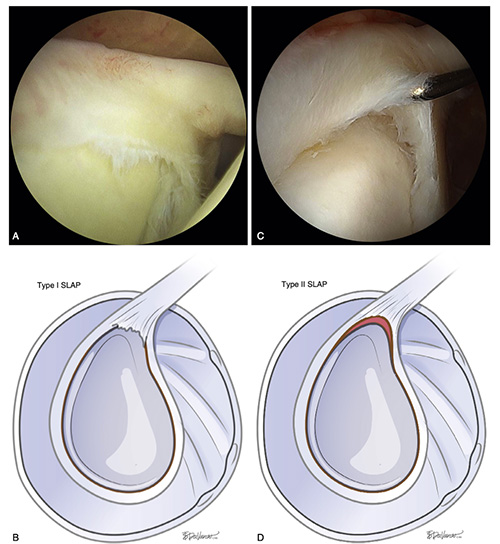SLAP Tears
What is a SLAP Tear?
A Superior Labrum Anterior and Posterior tear, is referred to a “SLAP” tear. This is a specific type of pattern in the labrum of the shoulder. The labrum is the tissue that lines the rim of the glenoid to help keep the ball in the socket through a large range of motion. You can think of this like a golf ball sitting on a golf tee.

The labrum tissue supports the ball and socket of the shoulder joint. The labrum serves as a protection for additional shoulder stability. There are many important shoulder ligaments that also attach to the labrum. In a SLAP injury, the top part of the labrum is injured which is actually the origin of the biceps tendon attachment. This complex is commonly injured in athletes and can be a common source of pain.

A. Arthroscopic image and illustration (B) demonstrating a type I SLAP tear characterized by biceps and labral fraying with an intact biceps tendon anchor. This is most commonly treated with labral debridement at the time of arthroscopic surgery.
(C) and (D) demonstrate a Type II SLAP tear in which the biceps anchor is detached, this is typically managed with arthroscopic SLAP repair.

(E) Arthroscopic image and illustration (F) show a Type III SLAP tear with a bucket-handle tear of the superior labrum with an intact biceps tendon anchor. Operative management for type III SLAP tears involves debridement of the flaps.
Arthroscopic image (G) and illustration (H) show a type IV SLAP tear in which the bucket-handle tear extends into the biceps tendon root. These injuries are often treated with a biceps tenodesis.

(B) Arthroscopic image from a left shoulder demonstrating detachment of the superior labrum (Type II).
(C) Arthroscopic repair of the type II SLAP tear using a knotless anchor technique.
If you have any questions regarding SLAP tears please contact Dr. Zahab Ahsan or Sincer Jacob.
At a Glance
Dr. Zahab Ahsan
- Board Certified & Fellowship-Trained Orthopedic Surgeon
- Former Assistant Team Physician for the NY Knicks
- Castle Connolly Top Doctor
- Team Physician for Chicago Fire FC
- Learn more


